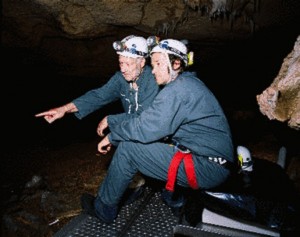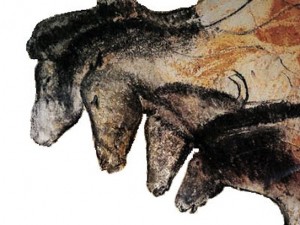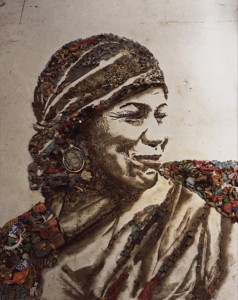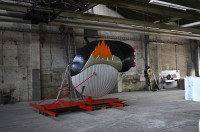If you missed them on the big screen like I did, you can still see these two recent art movies on DVD — from Netflix or from your library.
I heard the interview with Werner Herzog, director of Cave of Forgotten Dreams, on Fresh Air and it sounded like a fantastic documentary. The filmmaker and his crew get special access to the Chauvet Cave in Southern France, with wall drawings made some 32,000 years ago, that were just discovered in 1994. Herzog’s movie, shot in 3D, has lots of fantastic footage of the cave paintings and the beautiful cave itself (in the dark reaches below a stunning and rocky valley). But, at 90 minutes, the movie drags a little — how much cave can you watch before crying uncle.

The interviews with scientists get a little repetitive, and Herzog — a real poet of cinema — waxes on and on about the wonders, and about the true difficulties of filming in the cave. I didn’t see it in 3D so maybe it was more amazing that way–maybe it had the “you are there” affect that might have made you quake at the wonders. But on my large iMac computer screen the cave shots are quite eloquent enough without the 3D — it’s just there were a little too many of them.

The one great plus throughout is the voice of Werner Herzog. You get to spend a lot of time with his melodic voice, drawn-out vowels and precise diction. There’s no other voice like it. (Listen) At one point he calls for silence, “So we can listen to the cave and perhaps hear our own heart beats.” It’s one of his grand over the top moments of enthusiasm.
Hardly a spoiler, because this is not a suspense thriller or a whodunnit, but I will say that the postscript to the movie is unexpected. It shows supposedly radioactive albino crocodiles, possibly mutants created by the waste from a nearby nuclear power plant. (Herzog, who says he tells “ecstatic” truth instead of, as he puts it in his conversation with Stephen Colbert, truth like you find in the phone book, concedes this coda is “ecstatic” storytelling). Wherever the truth lies, it’s an eerie and completely downbeat moment that allows you to think of our scary future in the context of this wide-eyes and exultant take on our prehistoric past. The film is definitely worth seeing, to set your eyes on those ancient wall works.

Documented in this movie is Brazilian-born artist Vik Muniz‘ 3-year project in the trash landfills of Rio de Janeiro. The film follows a group of trash/recycling pickers the artist meets and befriends in the landfills (these are people who make a living from picking through trash and recouping recyclables for resale). Muniz takes their pictures, in sequences that seem jaunty and uplifting…the artist quips that it doesn’t even smell too bad (something I was dubious about). But this is not disaster tourism — the artist has far more than taking pictures in mind. In fact, his idea is to empower these people by getting them to join in his bigger project. Muniz, who was himself born poor, he says, is giving back to people he identifies with.
So, he employs the trash pickers whose pictures he has taken (it’s not clear whether he’s paying them but you believe he is). And they help him organize the trash he will use in the making of his signature tromp l’oeil portrait photographs, the ones built up from pieces of trash, which are photographed from on high.

In the course of the movie, Muniz visits the pickers in their homes in the favelas, huts really, and you see the absolute nothingness these people live with. And as the characters get fleshed out you begin bonding with them, so that when Muniz’ project is coming to the end and the trash photos have been made, you are heartsick when one after another of the pickers state that they don’t want to go back to work at the landfill. What has Muniz done? Will he abandon these folks to their fates after they have seen a better life, a more interesting/less dangerous form of work?
While it’s not a rags to riches movie, there is an element of that with some of the pickers. The movie is filled with sweet moments — the artist is sweet; the pickers are sweet; there is great dignity amidst the squalor. This is a 3-hankie winner. It will move you. No wonder it won the audience award at Sundance in 2010 and several other awards as well. Don’t let anyone tell you art can’t be a change agent. Just tell them to watch this movie.







